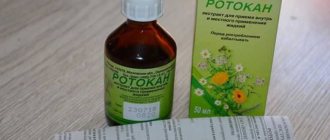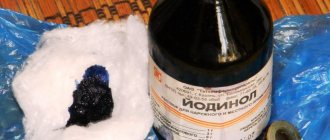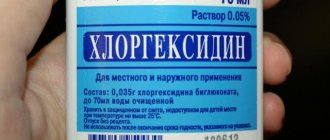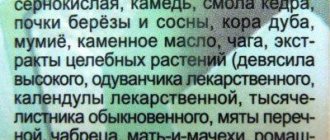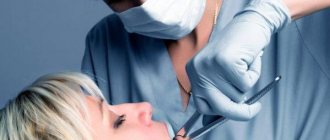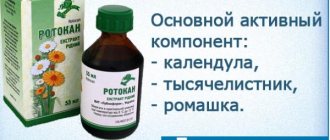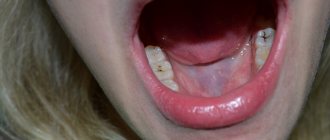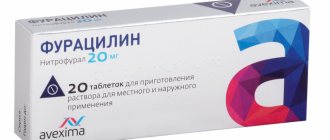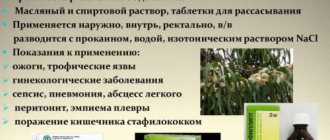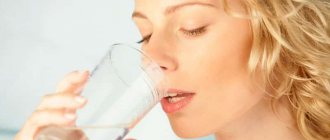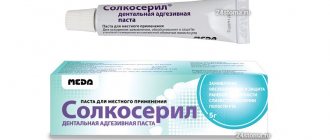The pharmaceutical product Rotokan is a natural anti-inflammatory drug, made from extracts of many plants.
Rotocan solution helps well with pathologies caused by damage to the mucous membrane and infection. The instructions included with the medication describe in detail how to use the drug.
Composition and release form
Rotokan is intended for external and internal use. Sold in the form of an aqueous-alcoholic extract.
The drug contains natural ingredients. These are chamomile, yarrow and calendula. This plant complex strengthens the capillary wall, providing a pronounced homeostatic effect. It also helps restore the integrity of the mucous surface and exhibits an antimicrobial effect.
When used orally, the product improves the functioning of the gastrointestinal tract.
Available in bottles of 25, 50 or 100 ml. The set includes a dropper dispenser and instructions for use. The extract is a liquid with a dark brown tint and a specific odor.
Ethyl alcohol acts as an excipient.
Dispensed from the pharmacy without a doctor's prescription.
Analogues of the drug
The medicine Rotokan is unique in its composition. Among the complete analogues one can name the drug Rotocan Vilar. The product has exactly the same composition and indications.
Other Rotokan analogues differ in their mechanism of action in their composition and in that they are not intended for oral use. This is Miramistin, Chlorhexidine. Rotokan for tonsillitis is replaced with Stomatidin, Iodinol.
Stopangin and Hexoral aerosols and sprays are used for the same diseases. Rotokan for inflammation of the gums and similar problems of the oral cavity is replaced with Maraslavin or Stomatidin.
Compared to almost all of the listed products, Rotokan is 3 times cheaper.
Analogs by mechanism of action for use in gastroenterology: Treatment and prophylactic collection No. 3, Gastroflox herbal tea. Keep in mind that the compositions of the drugs are different, the lists of indications and methods of use will also be different.
Therapeutic effect
Rotokan belongs to the group of herbal remedies with complex action. The main pharmacological property is anti-inflammatory. Provided thanks to plant extracts.
The drug has the following therapeutic effects:
- Antiseptic - observed due to the content of chamomile and ethyl alcohol in the composition. Helps against a large number of gram-positive bacteria.
- Antispasmodic - herbs have a pronounced sedative effect, can relieve muscle hypertonicity and muscle tension in internal organs.
- Restorative – rapid regeneration of epithelial cells is noted, effective for ulcerative lesions.
- Hemostatic - the natural components of the drug strengthen the vascular and capillary walls, preventing the development of minor bleeding.
- Analgesic – achieved in combination with a number of pharmacological properties.
Removal of a tooth
Is it necessary to use Rotokan after tooth extraction, and what are the dangers of root removal? There is no consensus regarding rinsing the mouth after dental surgery. Some doctors believe that rinsing with solutions removes a naturally formed blood clot, which acts as a barrier against the penetration of dirt and infection into the wound.
The ban on rinsing after surgery to remove a root/tooth is based on the assertion of possible suppuration of the wound and the spread of infection on the surface of the gum tissue. However, a number of doctors consider rinsing necessary. Why? Their arguments are based on the following arguments:
- rinsing helps remove food particles after eating;
- eliminates the accumulation of microorganisms in the wound;
- creates the prerequisites for rapid tissue healing.
If there are carious, untreated teeth around the wound surface after root removal, the risk of infection is very high. Bacteria can also move into the wound from poorly cleaned teeth and plaque.
This condition of the oral cavity can lead to the development of alveolitis and foci of inflammation in the wounded gum. Timely sanitation reduces the aggressiveness of microorganisms and eliminates their impact on the wounded mucosa.
For sanitization, you can use medical products, soda/salt solutions and infusions of medicinal herbs.
How to rinse your mouth correctly? You should keep the medicinal solution in your mouth without active action of the facial muscles: do not rinse, but arrange a medicinal bath inside the oral cavity. After holding the solution, you should simply spit the liquid out of your mouth. Baths should be done every 15-16 minutes until the mucous membrane heals. In this case, the blood clot will not be washed out of the wound and will continue its protective effect.
Adviсe:
- stop eating/drinking immediately after surgery;
- do not use tobacco and alcoholic beverages for a while;
- do not go to the steam room or take a hot bath/shower on the day of surgery;
- exclude heavy physical activity and psychological stress.
Compliance with the recommendations listed will facilitate the healing of the wound surface.
Instructions for use
The drug can be taken orally, topically and rectally. Each method has some features.
The extract is not used in its pure form; before use, the product is first diluted with water.
The course of therapy depends on the diagnosis, the age of the patient and the severity of the pathological process. For dental diseases, it is effective to rinse and apply applications. This is relevant for the treatment of stomatitis and other inflammatory lesions of the mucous membrane. Use a diluted solution, 1 teaspoon of the drug per 200 ml of water. In Rotokan, cotton swabs are moistened and applied to the affected areas for 25 minutes. The frequency of procedures is up to 4 times a day for a week.
Treatment of periodontal tissue with a solution is carried out immediately after removing plaque, tartar and cleaning the gum pockets from pathological contents. To do this, turundas soaked in Rotokan are placed in the periodontal areas for 20 minutes. The duration of the procedure is up to 6 manipulations, 1 time per day.
For pathologies of the gastrointestinal tract, the medicine can be taken rectally and orally in diluted form.
For internal use, the course of therapy is 10 days, maximum 3 weeks. The solution is drunk 2-4 times a day, 130 ml. Take 30 minutes before meals or an hour after meals.
To administer microenemas, 1 teaspoon of Rotokan is diluted in 100 ml of warm water. The procedure is carried out after emptying the intestines up to 2 times a day. The maximum course of treatment is 3 weeks.
The antiseptic drug is also effective for sore throats. In this case, rinse for 7 days with a low concentration solution.
Medicinal properties
Rotokan has a complex effect. The combination of bioactive plant substances provides the therapeutic effects of Rotokan in dental and ENT practice.
Chamomile ingredients have anti-inflammatory, analgesic and antispasmodic effects. Azulenes in the raw material have anti-allergenic and bacteriostatic effects. Calendula enhances the antimicrobial and other properties of the drug.
Herbal phytoncides are destructive to pathogenic microorganisms. Lycopene and carotenoids have an antioxidant effect, that is, they prevent cell destruction due to free radical attack.
Rotokan has local hemostatic and healing effects due to flavonoids, terpenoids and tannins of yarrow.
The medicinal components in the composition help stop bleeding in the oral cavity. The mechanism of action of the drug is aimed at accelerating blood clotting and reducing blood flow in the affected area of the mucosa.
Indications
Rotocan in dentistry and ENT practice is used for inflammation of various etiologies. The causes of pain, swelling, and bleeding of the mucous membrane are microbes and damage, including burns.
Rotokan for stomatitis acts on fungal and bacterial infections. The remedy is more effective at the initial stage of the disease.
Indications for the use of Rotokan for dental diseases:
- aphthous and erosive stomatitis in the form of ulcerative lesions of the mucous membranes of the lips and cheeks;
- ulcerative necrotizing gingivostomatitis;
- infection of dental alveoli;
- periodontitis;
- periodontal disease;
- gingivitis.
The drug is used for rinsing for diseases of the tongue, pharynx and larynx. The herbal remedy reduces the manifestations of the inflammatory process during glossitis, pharyngitis, and tonsillitis.
Treatment with Rotokan alone is less effective than a combination of rinsing with a solution and using other medications and folk remedies.
The use of Rotokan internally helps with the following problems of the digestive tract:
- gastritis with low acidity of gastric contents;
- enterocolitis of various origins;
- chronic enteritis and colitis;
- functional dyspepsia;
- gastroduodenitis.
In gastroenterology, the drug is prescribed as part of complex therapy. In addition to ingesting the solution, it is necessary to take antispasmodics, enzyme and other drugs, and follow a diet.
special instructions
It is not recommended to exceed the duration of the course without consulting a specialist. If there is no positive dynamics in treatment, you must stop taking the medication and consult a doctor.
People suffering from high stomach acidity should take the drug with caution. In this case, antacids should be used in parallel.
Rotokan is not prescribed for children. This is due to the high risk of allergic reactions.
Since the medicine contains ethyl alcohol, it is not advisable for alcohol addicts and people with impaired liver function or excretory system to take it.
The drug should be used with caution in the elderly to avoid the development of adverse reactions.
Reviews about the product
Svetlana, 27 years old:
I often use Rotokan for toothache and gum swelling. The wisdom tooth does not erupt in any way and periodically gives a signal of itself with unpleasant painful sensations. Rotokan fixes the problem very quickly.
Galina, 46 years old:
After removing wisdom teeth or damaged carious stumps, you should not rinse with hot soda or saline solutions. A friend of mine did this and ended up bleeding from her gums. The doctors barely stopped him. I take baths from Rotokan/Romazulan for a few seconds, but often. You can’t gurgle in your mouth, you just need to take some liquid and hold it.
Marina, 29 years old:
They removed my tooth, and in the evening I decided to treat the wound with traditional decoctions (sage and chamomile). And that’s what happened - particles of grass got into the wound. I filtered the broth, but the wound was still clogged. Then I learned that you can’t actively gurgle in your mouth, and it’s better to use Rotokan solution instead of traditional herbs. I'll keep this in mind for the future.
Tamara, 37 years old:
My husband got a flu infection on Saturday. A neighbor advised me to make lotions from Rotokan - soak gauze and apply it. Thank you very much for the advice: at first the flux stopped hurting, then it began to decrease. Along with the lotions, my husband also rinsed his gums slowly - he held the liquid in his mouth and spat.
Bottom line
If you follow the instructions correctly, Rotokan will relieve swollen gums, remove ulcerative formations on the mucous membrane and neutralize the oral cavity from pathogenic agents - microbes.
When using Rotocan, after removing a tooth root, you should first rinse your mouth with boiled water, and only then take a medicinal bath with the drug. Active movements of the facial muscles should not be allowed.
In the presence of serious systemic disorders of the body (renal failure, etc.), the drug is not recommended. The use of the product by children is prohibited as it contains alcohol.
Sources used:
- Preventive dentistry / I.K. Lutskaya. - Moscow
- Diagnosis, treatment and prevention of periodontal diseases / A.I. Nikolaev. - M.: MEDpress-inform, 2008.
- Apteka.ru
Side effects
Rotocan quite rarely provokes adverse reactions if used for inhalation. However, during procedures with a nebulizer, the active components penetrate deep into the tissue, so the risk of complications cannot be excluded.
The most common side effects:
- A rash on the body, spreading to the abdomen, back, sides and limbs. Sometimes rashes appear on the skin of the face, which leads to additional psychological discomfort.
- Itching of the skin in the area of the rash, which leads to scratching of the lesions. With the development of such a complication, the risk of infection increases.
- Headache, dizziness, which worsens immediately after the procedure and persists for several hours after it.
- Nausea and bouts of vomiting. In this case, emptying the stomach does not alleviate the patient's condition.
- Deterioration of appetite, up to its complete absence.
- Drowsiness.
- Decreased performance, both mental and physical.
- Depressive state, apathy.
- A bowel disorder manifested as constipation or frequent loose stools.
- Elderly patients may experience increased heart rate and fluctuations in blood pressure.
General disorders are rare, but local reactions on the skin are considered the most common side effects when using the drug for inhalation.
Benefits of inhalation with Rotokan
Rotocan for inhalation with a nebulizer is used quite often today, which is due to its advantages over other medications.
The main advantage of this method of use is the penetration of the vapors of the plant solution directly into the affected bronchi and lungs. Thanks to this, a therapeutic effect is achieved without concomitant negative effects on the organs of the digestive tract.
The use of Rotokan helps reduce the amount of synthetic products that have not only positive, but also negative effects on the body.
Pain in the bronchi and lungs when using the herbal solution disappears almost immediately, which is also considered an advantage and allows the medicine to be used as an emergency remedy.
An additional advantage is the natural composition of the product, which reduces the risk of complications, although it does not completely eliminate it. In addition, Rotokan can be used in combination with other medications if the disease is severe and one solution is not enough to eliminate symptoms.
Contraindications
Despite the effectiveness of the product and its natural composition, there are contraindications that will become an obstacle to therapy.
The main ones are the following:
- Intolerance to the components of the composition or a tendency to allergic manifestations when taking herbal preparations.
- Bronchial asthma in the acute stage, when the patient receives hormonal and other medications.
- Severe liver and kidney pathologies. Renal and liver failure is considered a reason to refuse therapy. In addition, you should not use the medicine for cirrhosis, hepatitis or severe nephritis, glomerulonephritis.
- Infectious lesions of the brain.
- Traumatic brain injuries in the acute stage.
- The rehabilitation period after surgery on the abdominal organs.
- The period of bearing a child and breastfeeding.
It is worth noting that elderly patients with a history of heart failure, tachycardia, angina pectoris and other heart pathologies are prescribed inhalations with the solution with extreme caution. This is due to the influence of plant components, which can provoke negative reactions.
